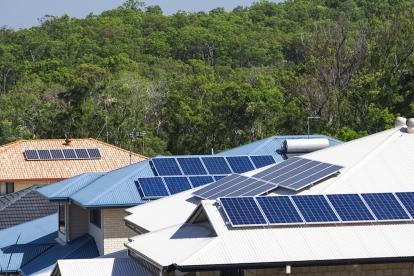Electricity prices are going through the roof and the continuing conflict in Ukraine does not bode well for imminent price decreases. Commercial property owners, aligning with the changing regulatory environment and listening to their tenants’ needs, are quicker to consider installing solar panels atop their commercial buildings. Certain regulatory issues should be considered before deciding to generate solar energy on real properties. The regulatory environment depends on many factors concerning such activity, in particular on the solar panels capacity, on the generated energy’s designation – whether for own or third-party (tenants’) needs – and, finally, on whether such activity would entail earning a profit on the delivered energy.
In principle, any business activity aiming at electricity generation must be licensed. However, no licence is required if solar energy is generated in either:
-
A small RES installation with the aggregate installed capacity between 50kW and 500kW, connected to the power grid of up to 110kV in which the aggregate installed electric power is between 50kW and 500kW.
-
A micro RES installation with the maximum aggregate installed capacity of 50kW, connected to the power grid of up to 110kV in which the aggregate installed electric power does not exceed 50kW.
Even though no licence is required, business operations that generate RES energy in small installations are still regulated and they must be entered in the Register of Energy Generators kept by the president of the Energy Regulatory Office (URE).
If an energy generator intends to use the energy solely for its own purposes, then it may not be considered a business venture requiring a licence.
One should bear in mind how a commercial building installation may be regarded in regulatory terms. Will it be considered strictly an internal installation – not required to comply with the Polish energy distribution laws? Or will it be seen as a distribution network – as provided for in the Polish energy law? An electric installation may be considered a distribution network if two conditions are met: (a) such installation is intended for energy distribution; and (b) it is owned by an energy enterprise, that is by an entity whose business is generation, transformation, storage, transmission, distribution of or trading in fuels or energy. If the building owner’s business operations satisfy the Polish energy law conditions qualifying it as an energy enterprise, it would be obliged to seek a separate energy distribution licence. The Polish energy law forbids a single entity to combine electricity generation and distribution. Therefore, if we were to consider an internal commercial building electric installation as a distribution network, then a multiparty structure would have to be put in place – with separate entities generating and distributing electricity.
An amendment to the 18 June 2021 Polish Energy Law Act, effective as of 2 July 2021, introduced a new concept – a closed distribution system. Following the footsteps of other EU countries, this concept aims at serving energy enterprises providing energy distribution services on a geographically limited area, an industrial zone, a commercial facility or a location where common services are being provided, whereas their main activity is not related to energy, in order to limit the administrative burdens on such activities. An operator that obtained an administrative decision recognising its system as a closed distribution system, as regards its business operations in such system, is exempt from the obligation to have its tariff approved and from the obligation to make development plans. However, such exemption is granted on the condition that the fees for the electricity delivered to end users of that system, calculated by the operator, may not exceed the payment calculated based on the tariff approved by the President of the Energy Regulatory Office for the energy enterprise, to which the distribution network serving the operator of a closed distribution system is connected. Alternatively, if it is not connected, it must relate to the prices approved for the energy enterprise on the area of which the closed distribution system has been created and, further, the settlement terms must be the same as in the tariff of that distribution network operator. Nevertheless, a closed distribution system operator is still obliged to maintain its accounting and financial policies in accordance with the Polish energy law. Introducing this new concept together with releasing from certain regulatory obligations was aimed at changing the existing market practice of building owners re-invoicing the costs of the energy delivered to the building to their tenants and at incentivising and strengthening competition on the Polish energy market.
In regulatory terms, it is also important if the building owner intends to deliver electricity to its tenants at a profit or if it simply aims to re-invoice it at its own costs to the tenants. Assuming that the tenants would not have individual electricity purchase agreements in that location with energy enterprises and the building owner would purchase it and settle it with tenants at its own costs, then re-invoicing the costs to the tenants without profit would not require the building owner to obtain a separate licence. However, under such circumstances, a building owner re-invoicing the energy costs to the tenants would need to sign an energy distribution agreement with the energy enterprise to whose distribution network the building’s electric infrastructure has been connected. In that case, energy cost reimbursement would need to be settled between the building owner and the tenants, based on the relevant lease agreement provisions, bearing in mind that such costs (re-invoice) cannot exceed those incurred by the building owner.
In practice, taking into account the above regulatory issues concerning electricity production and distribution, market participants are aiming at separating electricity production and distribution to specialised entities, allowing building owners to separate their usual property leasing activities from the risk, costs and burdens, including the tax risks relating to energy generation and distribution.




 i
i


